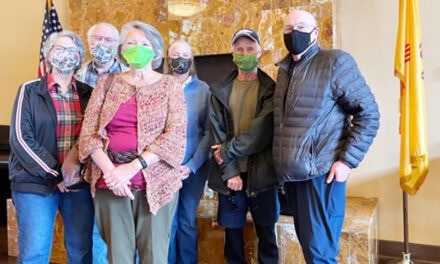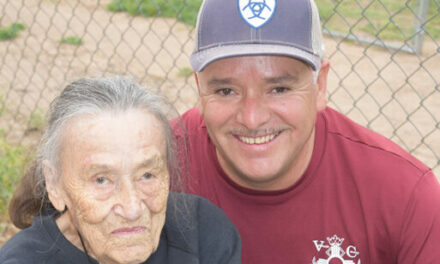
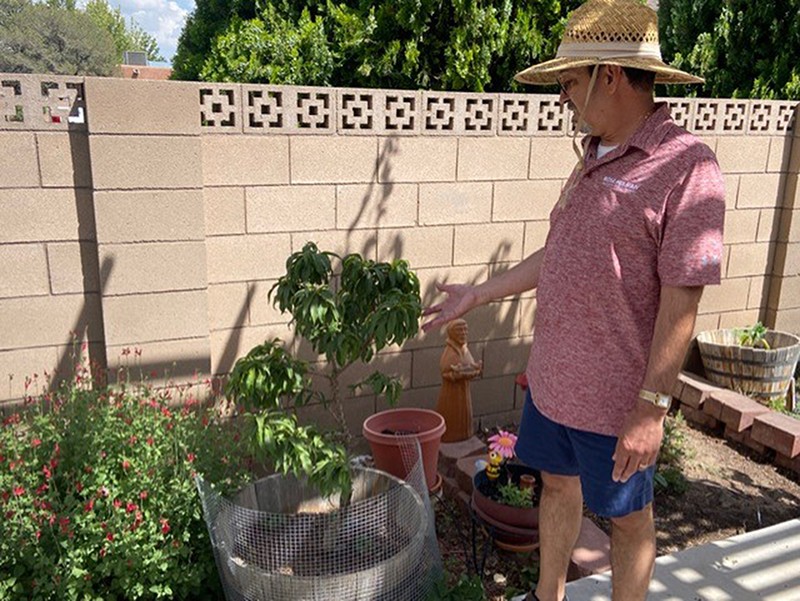
Clara Garcia | News-Bulletin photos
Rigo Chavez, who has helped teach the NMSU’s Seed to Supper program, has been gardening his entire life, starting with helping his father harvesting his vegetables and fruit. Chavez has numerous fruit trees on his property, including this sweet cherry tree, which he says, is at its end of its useful life.
Planning and planting, weeding and watering. The life of a gardener is a busy one.
For Rigo Chavez, a master gardener who lives in Los Lunas, the tradition was passed down from his father to him, and he has passed down his love for gardening to his two daughters.
“My dad always had a garden and we’d always help, mostly harvesting,” Chavez said of his father’s garden in Aztec, N.M. “I always wanted to get back into it because I enjoy the fresh vegetables, fresh tomatoes, fresh corn; my wife likes lima beans.
When Chavez and his wife, Miriam moved to Los Lunas 30 years ago, they decided to plant a little garden, although Miriam admits she’s a self-proclaimed “killer of plants.” They then moved to the house they’re living in now a few years later with an acre of property.
“We had a rather large garden but then my kids grew up and went to college, we stopped doing the large garden because it was just the two of us,” Chavez said.
Today, Chavez has a few plants — tomato, bell peppers and some herbs — in his backyard with several fruit trees — apple, sour and sweet cherries, peach, plums and pears — in a small orchard behind his house.
While his love of gardening didn’t downsize, his fruit yield increased as he became more knowledgeable through the master gardener program, which he began three years ago.
“Last year, as a result of my master gardener’s class, this was the first time I ever sprayed my trees for worms,” he said. “Using what I learned …we had more apples than we’d ever had before and know what to do with.”
With a green thumb in hand, Chavez decided to dedicate some of his volunteer hours with New Mexico State’s Seed to Supper program, which is a free vegetable gardening program focused on increasing access to healthy food.
Sally Cassady, who has been the ICAN food systems specialist with NMSU for five years, said the program — a six week course —is for adults, and is focused on getting gardeners who are trying to garden on a limited budget.
“We also try to show ways to get resources for low cost or for free,” Cassady said.
The six classes, which are taught once a week, have already wrapped up in Valencia County, help beginning gardeners with the essentials — planning, soil preparation, planting, garden care, harvesting and storage.
Planning
The first class, Cassady said, takes a little more time — about two hours — because there’s a lot of information, such as when to plant and what does well in New Mexic.
“We give an overview and explain how to decide what you’re going to grow,” Cassady said. “We recommend growing what you want to eat. I like eggplant, but I don’t love it, so I’m not going to grow 50 eggplants. You don’t want a bunch of stuff you’re not going to eat.”
For beginning gardeners, Cassady recommends growing Swiss chard because it’s great for dinner, and it can handle New Mexico’s soil and the heat of our sun.
“It’s a great one for someone who is just starting out,” she said.
Cassady also makes sure people think about the size of the garden they want, how much time they’ll have to tend a garden and how much help they will have.
“We’ll have them come up with a plan, when it’s appropriate to plant, create a map of the garden … and also think about their water source, convenience and sunlight.”
Cassady and Chavez also spoke to the beginner gardeners about the benefits of planting in the ground, in planters and even in raised-bed gardens.
“If people want to use (raised-bed gardens) they’re great if you have a bad back or you just don’t want to be getting down on the ground,” Cassady said. “The downside is it’s a lot more expensive because you have to build it and buy the soil. You just can’t take the soil and put it in the raised bed; it doesn’t work properly. For some people, it’s worth it.”
Where to plant your vegetables is also worth noting, as some plants do better in certain areas.
“When you go buy plants at a nursery or at a garden center, they’ll tell you tomatoes need full sun,” Chavez said. “In New Mexico, if you put tomatoes in full sun, they won’t do well because it’s just too intense here.
“It’s good to plant your tomatoes in a spot where they’ll get sun, but also shade in the afternoon, so it won’t get too hot for them.”
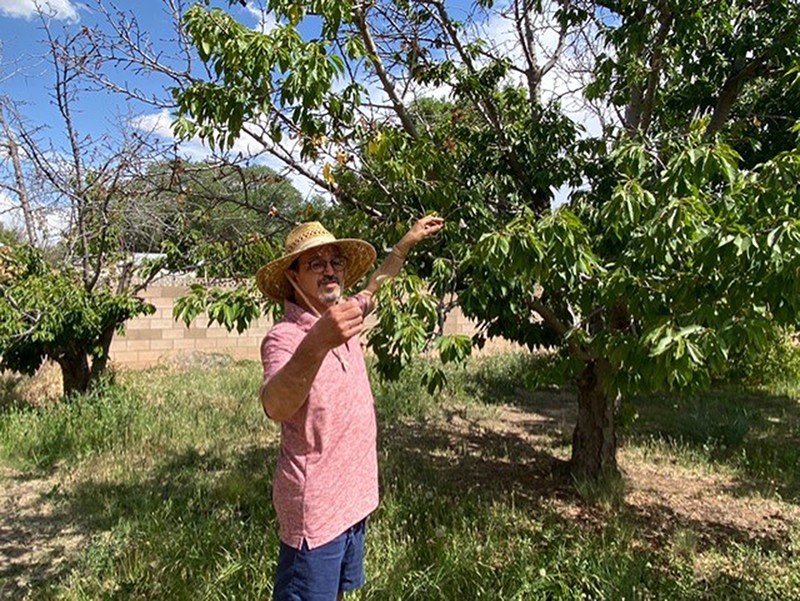
Rigo Chavez says one of the most important lessons he has learned when it comes to gardening is to grow what you like to eat. Chavez, a master gardener, grows these white grape vines on his pergola in his backyard in Los Lunas.
Soil prep
The secret of a healthy garden is in the soil, Cassady said, because the nutrients the plant needs are in the ground.
“The best thing to do if you have alkaline in the soil is to add organic material, such as compost, which will help.”
In New Mexico, there are typically three types of soil with clay, sand or both.
“It’s just adding that organic matter will help,” Cassady said.
Without the living layer of organics and soil bugs, soil is essentially dead. Although it may have enough nutrients to support a few struggling plants, it’s missing the living layer of soil that gives you a vibrant garden.
One way to successfully prep the soil, especially here in New Mexico, is to cover it.
“If you have bare soil, like a dirt lot, there’s not a lot of life in it,” Cassady said. “It gets compacted and the water can’t saturate down. A simple thing that someone can do to improve the soil, is to cover it with mulch. You can use cardboard, and often times, I will put wood chips on top.”
Cassady explained because the state doesn’t get a lot of moisture, this is a way to keep the moisture in the ground longer and doesn’t evaporate away.
“Covering the soil can also create a home for beneficial micro organisms,” she said. “It also helps keep the soil temperature lower.”
Planting
One of the first lessons of gardening is whether to plan from seed or by transplant.
Cassady said there are certain vegetables that you want to plant from seed — corn, root veggies, leafy greens, squash, melons and peas — because they don’t transfer well.
“With peppers, tomatoes, peppers and eggplants, I can grow them from seed, but I think at our climate and elevation, it’s better to plant them as transplants,” she said.
When it gets too hot, over 100 degrees, the tomato plant doesn’t focus on the fruit but rather just to live, she said.
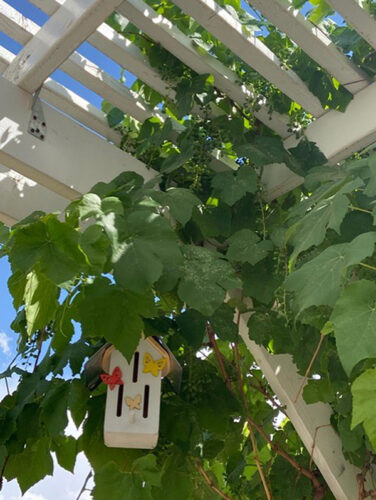
For Master Gardener Rigo Chavez, of Los Lunas, being able to grow fresh vegetables and fruit is one of the many benefits of gardening.
Garden care
The garden care portion of the course is broken up into two parts — watering and improving the soil, and pest management and weeds.
“A lot of times, people will think there is something wrong with their plant or think it’s a pest problem,” Cassady said. “The No. 1 cause of issues in a garden is human error. People accidently over watering, under watering or not fertilizing properly.”
Cassady said the trick is finding the right balance and the right amount of water.
Once your plant is established, Cassady recommends watering deeply and infrequently, making sure the water is making it to the roots.
“Some people will unintentionally only shallow water, where the water is only penetrating on the top two inches of the soil and the roots are not getting the moisture,” she said. “The plant will not grow very big and won’t be able to handle the stressors, such as wind. Do a low-flow soak so the water seeps down into the soil for longer than a minute or two.”
Weeds, Cassady said, are technically anything that grows where you don’t want it in your garden. She said there are a lot of publications and information on the NMSU website, extension.nmsu.edu, to help gardeners identify weeks.
“The biggest thing with weeding is if you are overwhelmed and have too much, is you need to prioritize,” she said. “If you can get those before the seeds drop, you’ll save yourself a lot of time and work. Go for what’s the most invasive, because it’s the hardest to get rid of.”
Cassady said weed control is easier to handle if you’re consistent in weeding your garden daily or even every other day.
“If you are growing in the ground, you’re going to have weeds. It’s just staying on top of it,” Cassady said. “It’s so much easier to pull a small weed rather than a huge weed or weeds that are out of control.”
Harvesting
After all that work, it’s time for harvesting, but Cassady said gardeners have to keep a close eye on what they’re growing and when to harvest.
“You’re looking at different indicators,” she said. “Cucumbers and summer squash, like zucchini, can grow fast.
“You really have to pay attention because if they get too big, they don’t taste that good,” Cassady said. “You’re looking for 6 to 8 inches for the cucumbers you’re going to eat.”
She also recommends to pay attention to those vegetables that are hidden under leaves.
“Ideally, the best time to harvest is in the early morning or evening when the temperatures are cooler,” she said. “Not only is it going to keep you cooler, but it’s better for the vegetables or fruit you’re picking.”
Cassady said to make sure once the vegetable is harvested, get it into a cool space, such as inside your house or even in the refrigerator depending on the food.
“Be gentle not to bruise it because it will last longer,” she said.
Storage
“We don’t go into a lot of detail in the class about storage, but there resources out there with the extension offices for food preservation, such as canning, drying and more,” Cassady said.
Chavez said all of his students have enjoyed the class and he enjoys teaching it.
“In our last class, I like to take something they would have made with their fresh produce, so one time, I took a zucchini frittata,” Chavez said. “This last time I took apple turnovers.”
While Chavez is a master gardener, he says he too even struggles sometimes.
“You’ll never be perfect and there’s always more to learn,” he said.
Click the above advertisement for more information
Clara Garcia is the editor and publisher of the Valencia County News-Bulletin.
She is a native of the city of Belen, beginning her journalism career at the News-Bulletin in 1998 as the crime and courts reporter. During her time at the paper, Clara has won numerous awards for her writing, photography and typography and design both from the National Newspaper Association and the New Mexico Press Association.



